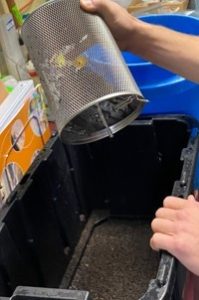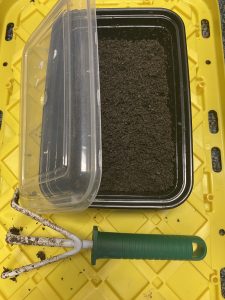Introduction
Cowpea (Vigna unguiculata), variety “Iron/Clay” is an abundant source of high protein plant biomass. This plant material can be composted to produce a net gain in total nitrogen on the farm. After mixing and management, storage-ready compost can be made at medium scale in under a year and ready to use for various soil conditioning or seed-starting purposes in two. First, a carbon source, such as pine wood chips, are mixed with a nitrogen source, such as cowpea to construct the piles. Then, after months of pile management, the product is ready for storage.

Objectives
The objectives were 1) supply the farm with compost to reduce fertilizer input, and 2) create bulk potting medium to start seeds and reduce nursery costs. Therefore, cowpea was grown, pine wood chips were, stockpiled, and compost piles were constructed.

Plant Growth
Cowpea seeds were broadcasted on lightly disked no-till rows containing organic material and wood chips (Figure 4). A 1,500 sq. ft. plot produced about 2 tons fresh plant biomass. No fertilizer was used. Cowpea has excellent nitrogen fixation capabilities and minor pest issues.
TIMELINE: Two years
Year 1: Seed cowpea in May; grow all summer
Fall: Harvest in September, construct piles, and re-mix every 2 weeks until October
Winter: Consolidate all compost piles; moisten, stir, and “fluff” weekly.
Early Spring (the following year): Store in containers; send sample to Livestock Waste Testing Laboratory
Year 2: Compost is useful after one year in storage. Do not use if compost has a sour or rotten smell. This smell can occur from being left too long in a closed container because the humidity creates conditions for anaerobic microbes to thrive. This is why weekly opening, stirring, and “fluffing” to reintroduce oxygen is important for the storage and maturation process.

Plant Harvest
Cowpea plants were pulled from the field with a tractor and claw attachment, (Figure 5) taking advantage of the plant’s inter-locking stems. In its place, the ground was left clean and virtually weed-free. Four compost piles (100 cu. ft.) were constructed.


Pile Construction
Cowpea plants, inter-twined, were placed in a giant matted ball on a tarp and chopped into lengths of 1-2′ using an electric hedge trimmer, then layered with 2-3” pine wood chips in hardwire cages on pallets (to improve air circulation at base of pile). Piles were left uncovered, and cages removed two weeks later, when material was softer. Piles were re-mixed and layered with new cowpea shoots; this process was repeated 3 times until November. The compost piles were consolidated in January and the process of sieving and storage began in February.

Pile Management
Compost piles were kept well-moist and mixed monthly, reaching a maximum temperature in the upper 120’s F. Tarps were used to capture small particles and recycle them into the next pile. Eventually, compost piles were consolidated, as their volume decreased significantly. The remaining 4-month-old material was moved to an outside structure (Figure 9) and sieved a few weeks later. Infestations included Alabama jumping worms and fire ants.

Compost Storage
The consolidated compost pile was sieved at 1/2″ initially, then at 1/8″ for final sampling and storage. Fully sieved was stored in plastic containers, with enough empty space to allow air circulation. It was stirred biweekly and monitored for consistency, odor, and quality. The contents too large for the various sieves were recycled back into the pile for further decomposition.



Lab Results
Macro-nutrients
- Nitrogen (raw): 8.4 lbs./ton; (adjusted): 6 lbs./ton
- Phosphorus (P2O5): 3.6 lbs./ton
- Potassium (K2O): 2.7 lbs./ton
Physical and Chemical Characteristics
- pH: 7.7
- Moisture: 36.2%
- Total Solids: 63.8% or 637,909 mg/kg (1276 lbs./ton)
- Total Ash: 46.6% or 466,003 mg/kg (932 lbs./ton)
- Total Kjedldahl Nitrogen: 0.42% or 4,212 mg/kg 8.4 lbs./ton)
- Ammonia Nitrogen (NH3): 0% or 6 mg/kg (0 lbs./ton)
- Total Elemental Phosphorus (P): 0.08% or 789 mg/kg (1.6 lbs./ton)
- Total Elemental Potassium (K+): 0.11% or 1,116 mg/kg (2.2 lbs./ton)
- Copper (Cu): 5.81 mg/L
- Molybdenum (Mn): 32.23 mg/L
- Zinc (Zn): 25.47 mg/L
Nitrogen Losses
Nitrogen content as tested: 8.4 lbs./ton
- Nitrogen losses during application: 5% or 0.4 lbs./ton
- Nitrogen losses while awaiting incorporation: 25% or 2 lbs./ton
- Other nitrogen losses: 0% or 0lbs./ton
Estimated Available Nitrogen (N): 71.2% or 6 lbs./ton
Consolidated Sample 1

 4
4
